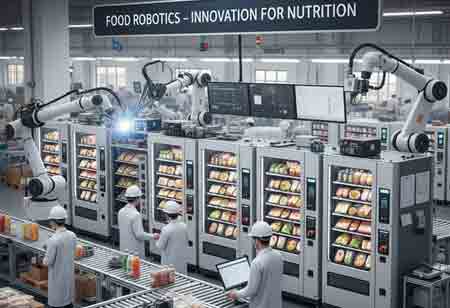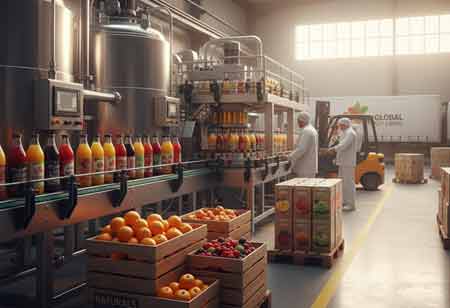Thank you for Subscribing to Food Business Review Weekly Brief
Factory-Grade Precision Meets Food Service: Redefining Vending Through Robotics
Robotic food automation transforms vending machines into sophisticated systems that leverage advanced mechanics and thermal management to deliver precise, customizable meals quickly and efficiently.

By
Food Business Review | Thursday, November 06, 2025
Stay ahead of the industry with exclusive feature stories on the top companies, expert insights and the latest news delivered straight to your inbox. Subscribe today.

The familiar vending machine, once a simple electromechanical dispenser of pre-packaged snacks, has evolved into the frontline of a sophisticated new industry: robotic food automation. This revolution is anchored in the convergence of advanced mechanical engineering, precision thermal management, and highly versatile dispensing technologies. Moving far beyond the simple "drop and grab," these systems are now complex mechatronic organisms designed for culinary precision.
Precision in Motion
The primary departure from legacy systems lies in the complete redesign of the internal mechanics. Multi-axis robotic systems have replaced the static spiral coil, fundamentally changing the machine's capabilities from mere dispensing to active handling and assembly.
At the center of this new architecture is a 3-axis or 5-axis robotic arm, or a gantry system operating on linear rails. This shift is critical. A gantry system, composed of a Cartesian robot, provides exceptional precision and rigidity, allowing a specialized tool to move with sub-millimeter accuracy in X, Y, and Z dimensions. This is essential for navigating a densely packed storage area and delivering an item to a precise "kitchen" or "pickup" location.
More advanced "articulated" or "SCARA" (Selective Compliance Articulated Robot Arm) arms offer greater flexibility, mimicking the dexterity of a human arm to reach around obstacles or access storage carousels from multiple angles. The design of these robotic systems prioritizes reliability and speed. They are built with high-cycle-count components—such as brushless motors, precision-ground ball screws, and robust bearings—to ensure they can perform tens of thousands of operations without failure.
Equally important is the "end-of-arm tooling" (EOAT), or the "gripper." This is no longer a one-size-fits-all mechanism. Modern systems use custom-designed EOATs tailored to the food products they handle. A vacuum gripper with soft, food-grade silicone cups might be used to lift a delicate pastry box or a salad bowl gently. A two-fingered parallel gripper could be used to grasp a bottled beverage securely. For bulk ingredients, spatulas or scoop-like tools may be integrated. This ability to gently lift, transfer, and place items—rather than dropping them—unlocks the potential to vend delicate, high-value, and multi-component meals.
Mastering Temperature Control
One of the most remarkable engineering achievements in modern food vending is the development of multi-zone thermal management within a single, compact system. To deliver fresh, ready-to-eat meals, these machines must simultaneously function as a freezer, refrigerator, and oven. This is made possible through advanced insulation, precise compartmentalization, and a network of intelligent sensors. The interior is divided into distinct thermal zones, each with its own dedicated refrigeration or heating system.
The frozen zone, operating at approximately –18°C (0°F), employs a high-capacity vapor-compression refrigeration cycle comparable to that of commercial freezers. It preserves ingredients such as ice cream, frozen pizza bases, and smoothie components in a deep freezer. The refrigerated zone, maintained between 2°C and 5°C (35°F and 41°F), serves as the primary area for storing fresh food—ideal for salads, sandwiches, yogurts, and other meal components. It uses a gentler refrigeration loop with forced-air circulation to maintain consistent temperatures and eliminate hot spots that could lead to spoilage. An ambient zone is designated for items that do not require temperature control, such as cutlery, napkins, condiments, and bottled beverages.
The true innovation, however, lies in the finishing stage. When a hot meal is ordered, a robotic arm transfers the selected item from cold storage to a specialized cooking station. Far from a conventional microwave, this station employs cutting-edge heating technologies that deliver restaurant-quality results in under 3 minutes. High-speed impingement ovens, for example, use jets of high-velocity, precisely heated air to cook food while rapidly enhancing texture and browning. Other systems integrate infrared, convection, or automated steam injection for precise reconstitution.
This entire thermal ecosystem is orchestrated by a sophisticated network of thermocouples and sensors that provide continuous feedback to a central controller. The result is a tightly regulated environment in which every meal—whether frozen, chilled, or freshly heated—is maintained and served at its ideal, food-safe temperature.
Dispensing Diversity
This engineering revolution lies in the capability to handle and dispense an exceptional range of product formats — from solid ingredients and delicate dishes to liquids, powders, and viscous sauces. This capability, known as multi-format dispensing, represents the core of next-generation automated food preparation systems. In this process, the robotic arm manages primary containers — such as bowls, cups, or boxes —while a specialized suite of dispensing technologies handles the actual ingredients. For instance, a machine preparing a custom salad, grain bowl, or barista-style coffee must coordinate multiple dispensers in precise sequence to ensure both accuracy and consistency.
For solids and granules—such as nuts, croutons, or shredded cheese—engineers employ vibratory feeders or auger-based dispensers. The auger, also known as Archimedes’ screw, uses a rotating helical shaft to deliver a consistent, measurable volume of material. By regulating the number of rotations, the system achieves exact portion control down to the gram.
For low-viscosity liquids like coffee, milk, or simple syrups, systems often rely on solenoid valves and precision pumps. Among these, peristaltic pumps are preferred for their hygienic design: since the liquid flows only through a sealed, food-safe tube, contamination risk is minimized and cleaning is simplified. Dispensing high-viscosity liquids—such as sauces, dressings, or purées—poses more complex fluid dynamics challenges. These applications require positive-displacement pumps capable of generating sufficient pressure to move thick fluids through nozzles without clogging, all while maintaining tight control over portion sizes.
The culmination of this process is an automated, miniature assembly line. The robotic arm places a bowl, which is then transferred to an auger for a rice base, then to a liquid dispenser for sauces, followed by a sequence of solid-ingredient dispensers for toppings, before finally being sealed and presented to the customer. This seamless, high-speed choreography of mechanical arms, thermal control zones, and volumetric pumps defines the cutting edge of automated, multi-format food dispensing.
The robotic vending machine revolution weaves together the precision of factory automation with the complex, non-uniform demands of the culinary arts. Through sophisticated mechanical design, multi-zone thermal management, and versatile dispensing technologies, engineers are building a new infrastructure for food service—one that is autonomous, precise, and endlessly adaptable. This technology is fundamentally reshaping our expectations of convenience, moving from a simple snack to a fully prepared, custom-engineered meal.
More in News






